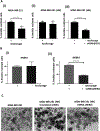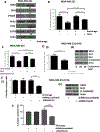HER2-mediated GLI2 stabilization promotes anoikis resistance and metastasis of breast cancer cells
- PMID: 30409762
- PMCID: PMC6311434
- DOI: 10.1016/j.canlet.2018.10.021
HER2-mediated GLI2 stabilization promotes anoikis resistance and metastasis of breast cancer cells
Abstract
Breast cancer metastasis is a multi-step process and requires cells to overcome anoikis. Anoikis is defined as cell-death that occurs due to loss of cell adhesion. During the course of cancer progression, tumor cells acquire resistance to anoikis. However, mechanisms of anoikis resistance are not clear. Human epidermal growth receptor 2 (HER2) overexpressing breast tumors are known to be highly aggressive and metastatic. The mechanisms correlating HER2 with metastasis are poorly understood. We observed increased anoikis resistance in HER2 overexpressing breast cancer cells. In addition, we identified that HER2 overexpression was also associated with increased sonic hedgehog (SHH) signaling especially GLI2, and that inhibition of SHH pathway suppressed anoikis resistance. GSK3β is known to facilitate proteasome-mediated degradation of GLI2. Moreover, we observed that silencing of GLI2 resulted in reduced migration and invasion of HER2 overexpressing cells. Anoikis resistant HER2 overexpressing cells also showed increased rate and extent of metastasis in vivo, as compared to wild type anoikis resistant cells. Taken together, this study indicates a novel role of HER2/GSK3β/GLI2 axis in anoikis resistance and metastasis, and that GLI2 could be a potential target for anti-cancer therapies.
Keywords: Anoikis resistance; Breast cancer metastasis; GLI2; GSK3β; HER2; Sonic hedgehog (SHH).
Copyright © 2018 Elsevier B.V. All rights reserved.
Conflict of interest statement
Conflict of interest
Authors declare that there are no competing interests.
Figures







References
-
- Hanahan D, Weinberg RA, Hallmarks of cancer: the next generation, Cell, 144 (2011) 646–674. - PubMed
-
- Guadamillas MC, Cerezo A, Del Pozo MA, Overcoming anoikis--pathways to anchorage-independent growth in cancer, Journal of Cell Science, 124 (2011) 3189–3197. - PubMed
-
- Slamon DJ, Clark GM, Wong SG, Levin WJ, Ullrich A, McGuire WL, Human breast cancer: correlation of relapse and survival with amplification of the HER-2/neu oncogene, Science, 235 (1987) 177–182. - PubMed
-
- Vogel CL, Cobleigh MA, Tripathy D, Gutheil JC, Harris LN, Fehrenbacher L, Slamon DJ, Murphy M, Novotny WF, Burchmore M, Shak S, Stewart SJ, Press M, Efficacy and safety of trastuzumab as a single agent in first-line treatment of HER2-overexpressing metastatic breast cancer, Journal of Clinical Oncology, 20 (2002) 719–726. - PubMed
Publication types
MeSH terms
Substances
Grants and funding
LinkOut - more resources
Full Text Sources
Medical
Research Materials
Miscellaneous

